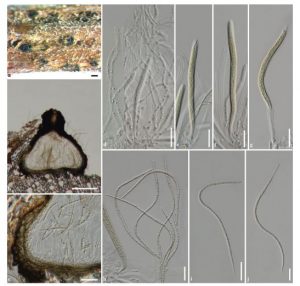Pseudoophiobolus mathieui (Westend.) Phookamsak, Wanas., S.K. Huang, E. Camporesi & K.D. Hyde, comb. nov. Index Fungorum number: IF553927
Basionym: Sphaeria mathieui Westend., Bull. Acad. R.Sci. Belg., Cl. Sci., se´r. 2: no. 5 (1859)
Synonyms: Gnomonia mathieui (Westend.) Lambotte, Fl. myc. Belg. (Verviers) 2: 254 (1880) Nodulosphaeria mathieui (Westend.) L. Holm, Symb. bot. upsal. 14(no. 3): 96 (1957) Ophiobolus mathieui (Westend.) Sacc., Syll. fung. (Abellini) 2: 342 (1883)
Possible types: Belgium, Beverloo, Camp, sur tiges d’Oenothera biennis, G.-D. Westendorp, BR5020104219417; Belgium, Beverloo, Camp, sur lestiges mortes de l’Oenothera biennis, G.-D. Westendorp & A.C.F. Wallays, BR5020104218403
Saprobic on flowering plants. Sexual morph: Ascomata 180–310 µm high (including papilla), 170–270 µm diam., dark brown to black, scattered, semi-immersed to erumpent through the host epidermis, subglobose to ampulliform, uni-loculate, glabrous, ostiolate, papillate. Papilla 90– 105 µm high, 90–100 µm diam., mammiform to oblong, with rounded to truncate apex, composed of several layers of thick, brown to dark brown cells, arranged in a textura angularis to textura prismatica, ostiole central, with pore like opening, lacking periphyses. Peridium 15–35 µm wide, composed of several layers, of brown to black, thick walled, pseudoparenchymatous cells, inner layers comprising 1–2 layers of hyaline, flflattened, thin-walled cells, arranged in textura prismatica, outer layers comprising several layers, of thickened, dark brown to black cells, arranged in textura angularis to textura globulosa. Hamathecium composed of dense, 2–4 µm wide, broadly cellular pseudoparaphyses, with small to large guttules, distinctly septate, slightly constricted at the septa, anastomosing at the apex, embedded in a hyaline gelatinous matrix. Asci (120–)125–140(–150) x 7–9 µm (x = 137.3 x 8 µm, n = 30), 8-spored, bitunicate, fifissitunicate, cylindrical to cylindric-clavate, short pedicellate, with furcate pedicel, apically rounded, with well-developed ocular chamber. Ascospores (104–)120–140(–160) x 2–3 lm (x = 131 x 2.6 µm, n = 30), fasciculate, scolecosporous, yellowish to yellowish brown, fifiliform, with rounded ends, tapered towards the lower cells, slightly swollen near the middle of the 4th or 5th cell from the apex, 13–15-septate, not constricted at the septa, smooth-walled. Asexual morph: Undetermined
Culture characteristics: Colonies on PDA reaching 28–30 mm diam. after 4 weeks at 25–30 C, medium dense, irregular, flflattened to slightly raised, surface smooth, edge undulate, flfluffy to flfloccose, slightly radiating at the margin, colony from above white to pale grey at the margin, greenish-grey to dark grey at the centre, colony from below, radiated with dark brown concentric ring, greenish-grey to dark grey at the middle, paler towards the margin, not producing pigmentation in agar.
Material examined: ITALY, Province of Forlı`-Cesena [FC], Teodorano—Meldola, dead stem of Salvia sp. (Lamiaceae), 12 October 2013, E. Camporesi, IT 1472 (MFLU 16-2043), living culture, MFLUCC 17-1784 = KUMCC 17-0159; ibid. Campigna—Santa Sofifia, on dead stems of Origanum vulgare L. (Lamiaceae), 9 June 2014, E. Camporesi, IT1923 (MFLU17-0928); Campigna— Santa Sofifia, dead stem of Ononis spinosa L. (Fabaceae), 25 August 2014, E. Camporesi, IT2074 (MFLU 17-0934), living culture, MFLUCC 17-1785 = KUMCC 17-0169.
Notes: Saccardo (1883) introduced Ophiobolus mathieui (Westend.) Sacc. to accommodate Sphaeria mathieui Westend. and described the species as having hyaline ascospores. Subsequently, Mu¨ller (1952) and Shoemaker (1976) examined and illustrated collections of O. mathieui from Europe and North America and mentioned that O. mathieui has hyaline to yellowish ascospores. Morphologically, our collections are typical O. mathieui in having pale yellowish ascospores swollen near the middle of the 4th cell (Mu¨ller 1952; Shoemaker 1976). Multigene phylogenetic analyses based on a combined LSU, SSU, TEF1-α and ITS sequence data showed that our strains formed a distinct clade distant from O. disseminans, the type species of Ophiobolus. Therefore, the new genus Pseudoophiobolus is established to accommodate the new combination, P.mathieui (= O. mathieui) and other ophiobolus-like taxa that are related to P. mathieui.
Hosts (not confifirmed by molecular data): Ononis spinosa L. (Fabaceae); Origanum vulgare L., Salvia sp. (Lamiaceae); Galium sp. (Rubiaceae); [as Ophiobolus mathieui: Apocynum androsaemifolium L. (Apocynaceae); Oplopanax horridus (Sm.) Miq. (Aralioideae); Achillea millefolium L., Anaphalis margaritacea (L.) Benth. & Hook.f., Chrysanthemum leucanthemum L., Cirsium palustre (L.) Scop. (Asteraceae); Echium vulgare L. (Boraginaceae); Melilotus sp. (Fabaceae); Mentha sp. (Lamiaceae); Scrophularia sp., Verbascum sp. (Scrophulariaceae)] (Mu¨ller 1952; Shoemaker 1976; Farr and Rossman 2017)
Distribution: Belgium, Canada, England, Germany, Italy, Latvia, Lettland, Norway, Pakistan (Shoemaker 1976; Farr and Rossman 2017).
FIG. Pseudoophiobolus mathieui (MFLU 16-2043). a Appearance of ascomata on the host surface. b Section through ascoma. c Section through peridium. d Pseudoparaphyses. e–g Asci. h–j Ascospores. Scale bars: a = 200 µm, b = 100 µm, c–j = 20 µm

